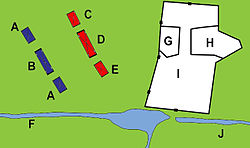Empress Matilda
Matilda of England (7 February 1102 – 10 September 1167) also called Empress Matilda or her nickname, Maud, was the Holy Roman Empress and Queen consort of the Romans as the wife of Emperor Henry V from their marriage in 1114 until Henry's death in 1125. She was also the Disputed Queen of England from April to November 1141[3] during a civil war that she fought against her cousin, King Stephen I, which was known as The Anarchy.[4] She was the daughter of Henry I of England and his first wife, Matilda of Scotland[5][6]
| Matilda | |
|---|---|

| |
| Depiction of Matilda in the 12th-century Gospels of Henry the Lion | |
| Lady of the English (disputed) | |
| Reign | 8 April 1141 — 1148[1][2] |
| Predecessor | Stephen I |
| Successor | Stephen I |
| Tenure | 7 January 1114 – 23 May 1125 |
| Spouses | |
| Issue | |
| House | Normandy |
| Father | Henry I of England |
| Mother | Matilda of Scotland |
| Religion | Roman Catholicism |
Matilda grew up with great education. She was incredibly intelligent and talented. At a young age, she learned how to speak multiple languages, mainly English, German, French, and Latin. She also learned how to fight like a knight and as well as learning archery.
She was very popular in Germany, however, she was not that popular in her homeland as she spend most of her childhood in Germany. Because of that, she was considered "foreign" and that England never had a queen and that the people back then believed that woman were weak. Thus, they didn't want Matilda to succeed her father as she was the next in line to the throne after her younger brother, William Adelin, died in a boat.
Her father planned her to succeed him. However, when Henry died in 1135, instead of Matilda ascending to the throne, her cousin, Stephen of Blios, took the throne and had himself crowned. However, Matilda refused to recognize Stephen as king and started The Anarchy. In April 1141, troops loyal to Matilda captured Stephen and imprisoned him and Matilda became the disputed monarch. However, the troops of King Stephen freed Stephen. However, Matilda refused to give up her claim to the throne.
Eventually in 1153, Stephen's son and heir, Eustace IV, died. Thus, Stephen and Matilda signed an agreement stating that when Stephen died, he will be succeded by Matilda's son, Henry, and not Stephen's other son, William. Eventually in October 1154, Stephen died and Henry became the King of England as Henry II.
Empress Matilda Media
A 14th-century depiction of the White Ship sinking of 1120
Contemporary depiction of Geoffrey of Anjou, Matilda's second husband
A Matilda silver penny, minted in Oxford
The Battle of Lincoln, 1141:*Template:Image key*
St George's Tower at Oxford Castle
Geoffrey of Anjou's invasion of Normandy, 1142–43
References
- ↑ David Williamson (1986). Debrett's kings and queens of Britain. Webb & Bower. p. 51. ISBN 9780863501012.
- ↑ George Palmer Putnam (1833). Chronology, Or, An Introduction and Index to Universal History, Biography, and Useful Knowledge. D. Appleton & Company. p. 70.
- ↑ Andrews, J. F. (2019-10-30). Lost Heirs of the Medieval Crown: The Kings and Queens Who Never Were. Pen and Sword. ISBN 978-1-5267-3652-9.
- ↑ Lewis, Matthew (2020-01-19). Stephen and Matilda's Civil War: Cousins of Anarchy. Pen and Sword. ISBN 978-1-5267-1835-8.
- ↑ Castor, Helen (2010-10-07). She-Wolves: The Women Who Ruled England Before Elizabeth. Faber & Faber. ISBN 978-0-571-27172-6.
- ↑ Hanley, Catherine (2019-04-23). Matilda. Yale University Press. ISBN 978-0-300-22725-3.









